Prevention and Control of Dust Explosions - Desklib
VerifiedAdded on 2023/06/15
|11
|3134
|482
AI Summary
This article discusses the prevention and control of dust explosions in industries, coalmines and workplaces. It covers the necessary conditions for a dust explosion, causes, and control measures such as ignition control, control of dust, relief and venting of explosion and providing training and awareness to the workers in workplaces.
Contribute Materials
Your contribution can guide someone’s learning journey. Share your
documents today.
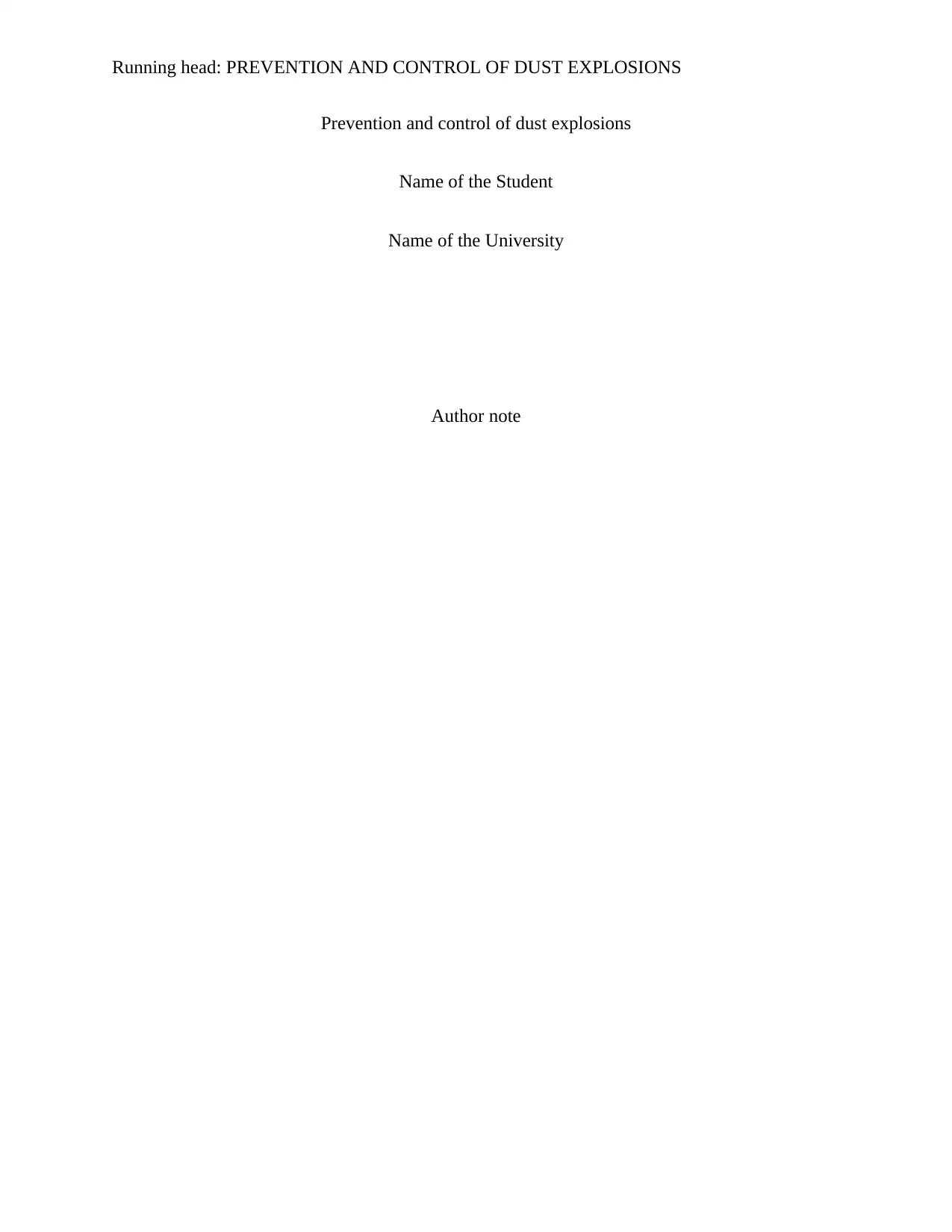
Running head: PREVENTION AND CONTROL OF DUST EXPLOSIONS
Prevention and control of dust explosions
Name of the Student
Name of the University
Author note
Prevention and control of dust explosions
Name of the Student
Name of the University
Author note
Secure Best Marks with AI Grader
Need help grading? Try our AI Grader for instant feedback on your assignments.
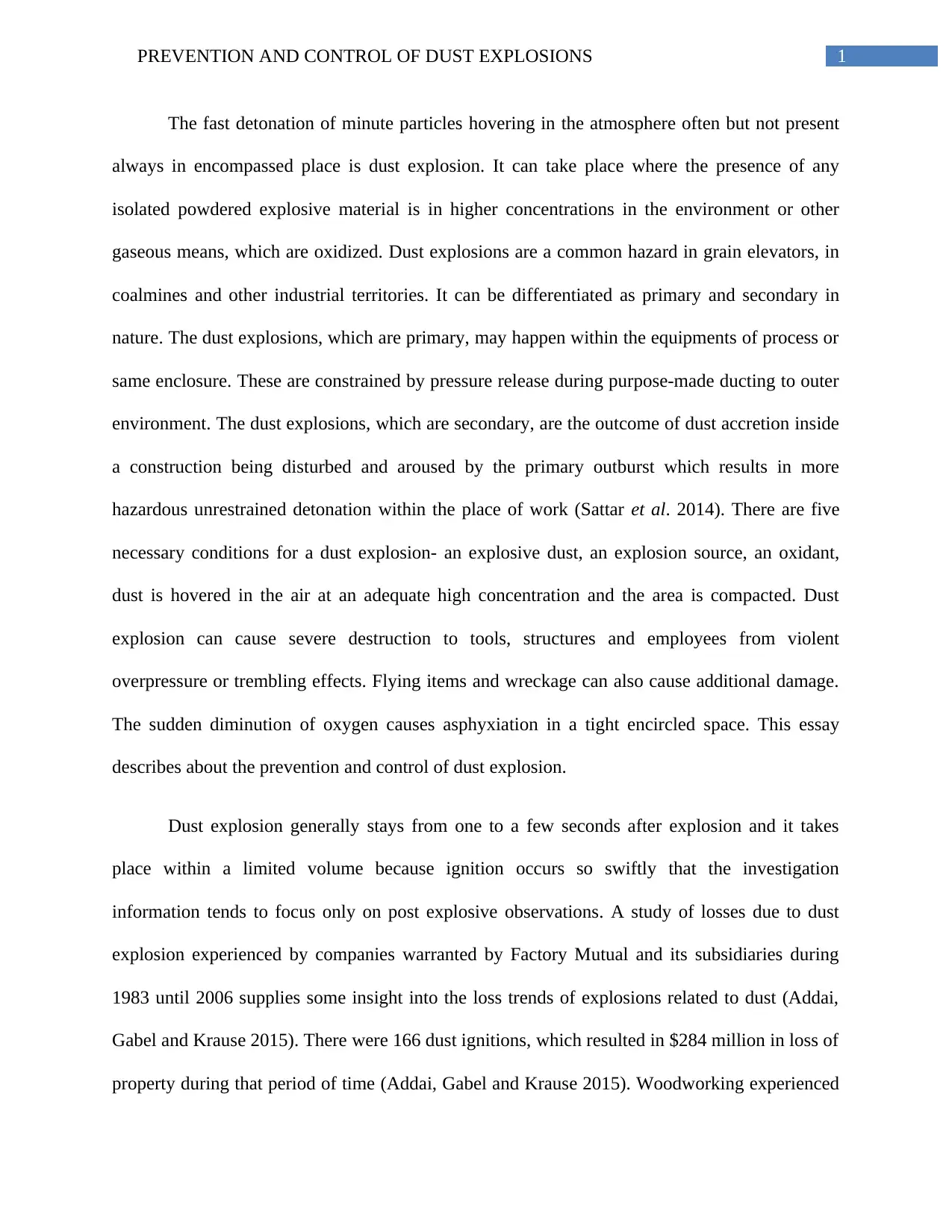
1PREVENTION AND CONTROL OF DUST EXPLOSIONS
The fast detonation of minute particles hovering in the atmosphere often but not present
always in encompassed place is dust explosion. It can take place where the presence of any
isolated powdered explosive material is in higher concentrations in the environment or other
gaseous means, which are oxidized. Dust explosions are a common hazard in grain elevators, in
coalmines and other industrial territories. It can be differentiated as primary and secondary in
nature. The dust explosions, which are primary, may happen within the equipments of process or
same enclosure. These are constrained by pressure release during purpose-made ducting to outer
environment. The dust explosions, which are secondary, are the outcome of dust accretion inside
a construction being disturbed and aroused by the primary outburst which results in more
hazardous unrestrained detonation within the place of work (Sattar et al. 2014). There are five
necessary conditions for a dust explosion- an explosive dust, an explosion source, an oxidant,
dust is hovered in the air at an adequate high concentration and the area is compacted. Dust
explosion can cause severe destruction to tools, structures and employees from violent
overpressure or trembling effects. Flying items and wreckage can also cause additional damage.
The sudden diminution of oxygen causes asphyxiation in a tight encircled space. This essay
describes about the prevention and control of dust explosion.
Dust explosion generally stays from one to a few seconds after explosion and it takes
place within a limited volume because ignition occurs so swiftly that the investigation
information tends to focus only on post explosive observations. A study of losses due to dust
explosion experienced by companies warranted by Factory Mutual and its subsidiaries during
1983 until 2006 supplies some insight into the loss trends of explosions related to dust (Addai,
Gabel and Krause 2015). There were 166 dust ignitions, which resulted in $284 million in loss of
property during that period of time (Addai, Gabel and Krause 2015). Woodworking experienced
The fast detonation of minute particles hovering in the atmosphere often but not present
always in encompassed place is dust explosion. It can take place where the presence of any
isolated powdered explosive material is in higher concentrations in the environment or other
gaseous means, which are oxidized. Dust explosions are a common hazard in grain elevators, in
coalmines and other industrial territories. It can be differentiated as primary and secondary in
nature. The dust explosions, which are primary, may happen within the equipments of process or
same enclosure. These are constrained by pressure release during purpose-made ducting to outer
environment. The dust explosions, which are secondary, are the outcome of dust accretion inside
a construction being disturbed and aroused by the primary outburst which results in more
hazardous unrestrained detonation within the place of work (Sattar et al. 2014). There are five
necessary conditions for a dust explosion- an explosive dust, an explosion source, an oxidant,
dust is hovered in the air at an adequate high concentration and the area is compacted. Dust
explosion can cause severe destruction to tools, structures and employees from violent
overpressure or trembling effects. Flying items and wreckage can also cause additional damage.
The sudden diminution of oxygen causes asphyxiation in a tight encircled space. This essay
describes about the prevention and control of dust explosion.
Dust explosion generally stays from one to a few seconds after explosion and it takes
place within a limited volume because ignition occurs so swiftly that the investigation
information tends to focus only on post explosive observations. A study of losses due to dust
explosion experienced by companies warranted by Factory Mutual and its subsidiaries during
1983 until 2006 supplies some insight into the loss trends of explosions related to dust (Addai,
Gabel and Krause 2015). There were 166 dust ignitions, which resulted in $284 million in loss of
property during that period of time (Addai, Gabel and Krause 2015). Woodworking experienced
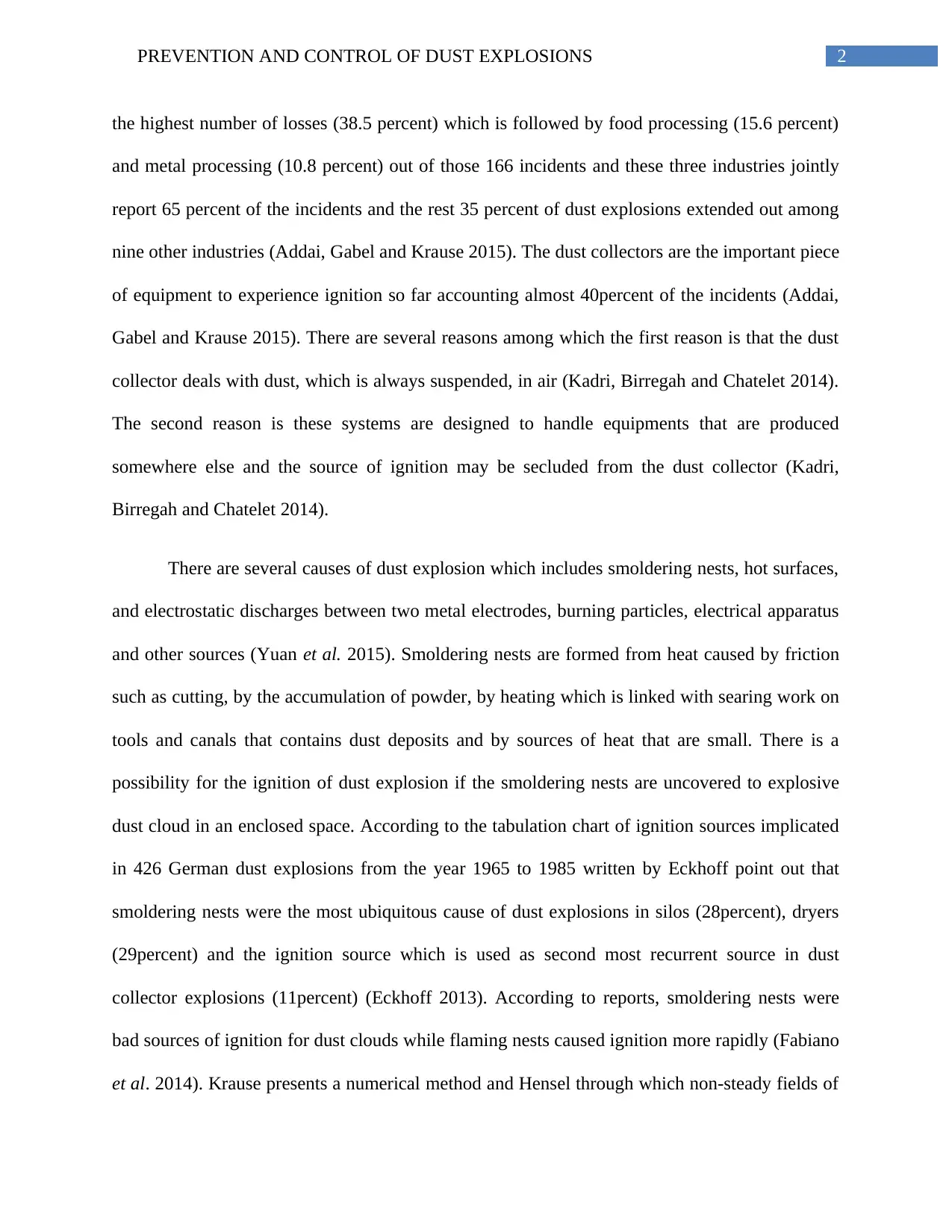
2PREVENTION AND CONTROL OF DUST EXPLOSIONS
the highest number of losses (38.5 percent) which is followed by food processing (15.6 percent)
and metal processing (10.8 percent) out of those 166 incidents and these three industries jointly
report 65 percent of the incidents and the rest 35 percent of dust explosions extended out among
nine other industries (Addai, Gabel and Krause 2015). The dust collectors are the important piece
of equipment to experience ignition so far accounting almost 40percent of the incidents (Addai,
Gabel and Krause 2015). There are several reasons among which the first reason is that the dust
collector deals with dust, which is always suspended, in air (Kadri, Birregah and Chatelet 2014).
The second reason is these systems are designed to handle equipments that are produced
somewhere else and the source of ignition may be secluded from the dust collector (Kadri,
Birregah and Chatelet 2014).
There are several causes of dust explosion which includes smoldering nests, hot surfaces,
and electrostatic discharges between two metal electrodes, burning particles, electrical apparatus
and other sources (Yuan et al. 2015). Smoldering nests are formed from heat caused by friction
such as cutting, by the accumulation of powder, by heating which is linked with searing work on
tools and canals that contains dust deposits and by sources of heat that are small. There is a
possibility for the ignition of dust explosion if the smoldering nests are uncovered to explosive
dust cloud in an enclosed space. According to the tabulation chart of ignition sources implicated
in 426 German dust explosions from the year 1965 to 1985 written by Eckhoff point out that
smoldering nests were the most ubiquitous cause of dust explosions in silos (28percent), dryers
(29percent) and the ignition source which is used as second most recurrent source in dust
collector explosions (11percent) (Eckhoff 2013). According to reports, smoldering nests were
bad sources of ignition for dust clouds while flaming nests caused ignition more rapidly (Fabiano
et al. 2014). Krause presents a numerical method and Hensel through which non-steady fields of
the highest number of losses (38.5 percent) which is followed by food processing (15.6 percent)
and metal processing (10.8 percent) out of those 166 incidents and these three industries jointly
report 65 percent of the incidents and the rest 35 percent of dust explosions extended out among
nine other industries (Addai, Gabel and Krause 2015). The dust collectors are the important piece
of equipment to experience ignition so far accounting almost 40percent of the incidents (Addai,
Gabel and Krause 2015). There are several reasons among which the first reason is that the dust
collector deals with dust, which is always suspended, in air (Kadri, Birregah and Chatelet 2014).
The second reason is these systems are designed to handle equipments that are produced
somewhere else and the source of ignition may be secluded from the dust collector (Kadri,
Birregah and Chatelet 2014).
There are several causes of dust explosion which includes smoldering nests, hot surfaces,
and electrostatic discharges between two metal electrodes, burning particles, electrical apparatus
and other sources (Yuan et al. 2015). Smoldering nests are formed from heat caused by friction
such as cutting, by the accumulation of powder, by heating which is linked with searing work on
tools and canals that contains dust deposits and by sources of heat that are small. There is a
possibility for the ignition of dust explosion if the smoldering nests are uncovered to explosive
dust cloud in an enclosed space. According to the tabulation chart of ignition sources implicated
in 426 German dust explosions from the year 1965 to 1985 written by Eckhoff point out that
smoldering nests were the most ubiquitous cause of dust explosions in silos (28percent), dryers
(29percent) and the ignition source which is used as second most recurrent source in dust
collector explosions (11percent) (Eckhoff 2013). According to reports, smoldering nests were
bad sources of ignition for dust clouds while flaming nests caused ignition more rapidly (Fabiano
et al. 2014). Krause presents a numerical method and Hensel through which non-steady fields of
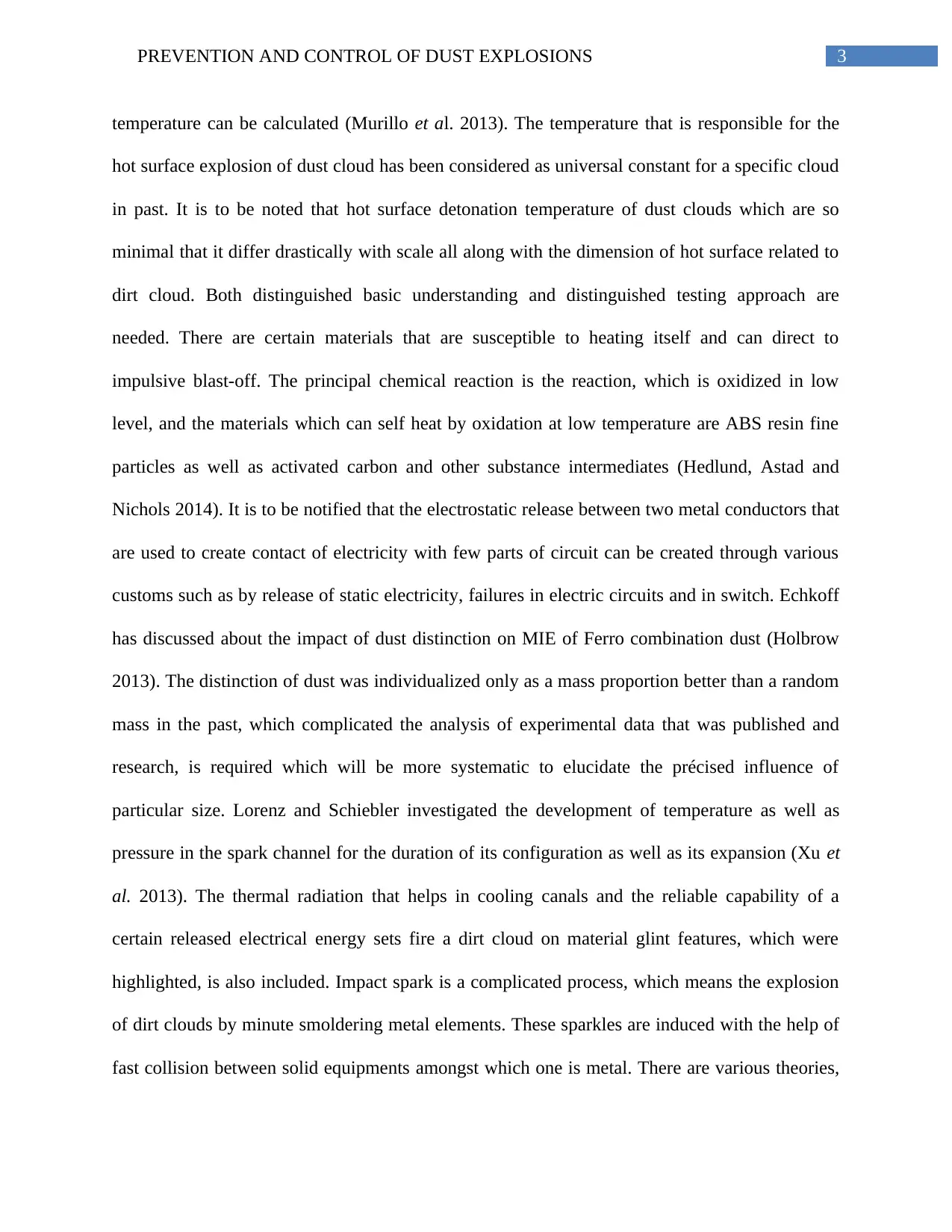
3PREVENTION AND CONTROL OF DUST EXPLOSIONS
temperature can be calculated (Murillo et al. 2013). The temperature that is responsible for the
hot surface explosion of dust cloud has been considered as universal constant for a specific cloud
in past. It is to be noted that hot surface detonation temperature of dust clouds which are so
minimal that it differ drastically with scale all along with the dimension of hot surface related to
dirt cloud. Both distinguished basic understanding and distinguished testing approach are
needed. There are certain materials that are susceptible to heating itself and can direct to
impulsive blast-off. The principal chemical reaction is the reaction, which is oxidized in low
level, and the materials which can self heat by oxidation at low temperature are ABS resin fine
particles as well as activated carbon and other substance intermediates (Hedlund, Astad and
Nichols 2014). It is to be notified that the electrostatic release between two metal conductors that
are used to create contact of electricity with few parts of circuit can be created through various
customs such as by release of static electricity, failures in electric circuits and in switch. Echkoff
has discussed about the impact of dust distinction on MIE of Ferro combination dust (Holbrow
2013). The distinction of dust was individualized only as a mass proportion better than a random
mass in the past, which complicated the analysis of experimental data that was published and
research, is required which will be more systematic to elucidate the précised influence of
particular size. Lorenz and Schiebler investigated the development of temperature as well as
pressure in the spark channel for the duration of its configuration as well as its expansion (Xu et
al. 2013). The thermal radiation that helps in cooling canals and the reliable capability of a
certain released electrical energy sets fire a dirt cloud on material glint features, which were
highlighted, is also included. Impact spark is a complicated process, which means the explosion
of dirt clouds by minute smoldering metal elements. These sparkles are induced with the help of
fast collision between solid equipments amongst which one is metal. There are various theories,
temperature can be calculated (Murillo et al. 2013). The temperature that is responsible for the
hot surface explosion of dust cloud has been considered as universal constant for a specific cloud
in past. It is to be noted that hot surface detonation temperature of dust clouds which are so
minimal that it differ drastically with scale all along with the dimension of hot surface related to
dirt cloud. Both distinguished basic understanding and distinguished testing approach are
needed. There are certain materials that are susceptible to heating itself and can direct to
impulsive blast-off. The principal chemical reaction is the reaction, which is oxidized in low
level, and the materials which can self heat by oxidation at low temperature are ABS resin fine
particles as well as activated carbon and other substance intermediates (Hedlund, Astad and
Nichols 2014). It is to be notified that the electrostatic release between two metal conductors that
are used to create contact of electricity with few parts of circuit can be created through various
customs such as by release of static electricity, failures in electric circuits and in switch. Echkoff
has discussed about the impact of dust distinction on MIE of Ferro combination dust (Holbrow
2013). The distinction of dust was individualized only as a mass proportion better than a random
mass in the past, which complicated the analysis of experimental data that was published and
research, is required which will be more systematic to elucidate the précised influence of
particular size. Lorenz and Schiebler investigated the development of temperature as well as
pressure in the spark channel for the duration of its configuration as well as its expansion (Xu et
al. 2013). The thermal radiation that helps in cooling canals and the reliable capability of a
certain released electrical energy sets fire a dirt cloud on material glint features, which were
highlighted, is also included. Impact spark is a complicated process, which means the explosion
of dirt clouds by minute smoldering metal elements. These sparkles are induced with the help of
fast collision between solid equipments amongst which one is metal. There are various theories,
Secure Best Marks with AI Grader
Need help grading? Try our AI Grader for instant feedback on your assignments.
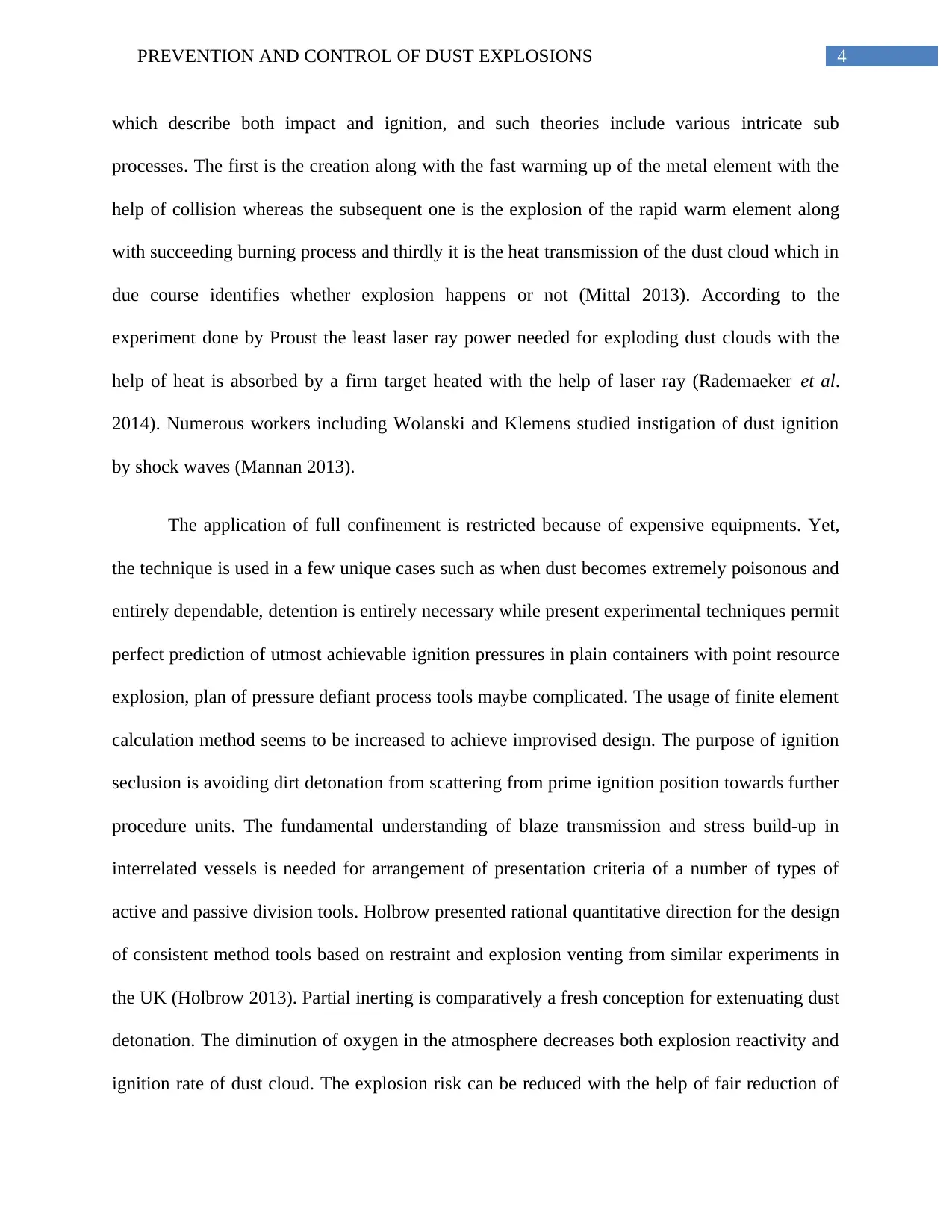
4PREVENTION AND CONTROL OF DUST EXPLOSIONS
which describe both impact and ignition, and such theories include various intricate sub
processes. The first is the creation along with the fast warming up of the metal element with the
help of collision whereas the subsequent one is the explosion of the rapid warm element along
with succeeding burning process and thirdly it is the heat transmission of the dust cloud which in
due course identifies whether explosion happens or not (Mittal 2013). According to the
experiment done by Proust the least laser ray power needed for exploding dust clouds with the
help of heat is absorbed by a firm target heated with the help of laser ray (Rademaeker et al.
2014). Numerous workers including Wolanski and Klemens studied instigation of dust ignition
by shock waves (Mannan 2013).
The application of full confinement is restricted because of expensive equipments. Yet,
the technique is used in a few unique cases such as when dust becomes extremely poisonous and
entirely dependable, detention is entirely necessary while present experimental techniques permit
perfect prediction of utmost achievable ignition pressures in plain containers with point resource
explosion, plan of pressure defiant process tools maybe complicated. The usage of finite element
calculation method seems to be increased to achieve improvised design. The purpose of ignition
seclusion is avoiding dirt detonation from scattering from prime ignition position towards further
procedure units. The fundamental understanding of blaze transmission and stress build-up in
interrelated vessels is needed for arrangement of presentation criteria of a number of types of
active and passive division tools. Holbrow presented rational quantitative direction for the design
of consistent method tools based on restraint and explosion venting from similar experiments in
the UK (Holbrow 2013). Partial inerting is comparatively a fresh conception for extenuating dust
detonation. The diminution of oxygen in the atmosphere decreases both explosion reactivity and
ignition rate of dust cloud. The explosion risk can be reduced with the help of fair reduction of
which describe both impact and ignition, and such theories include various intricate sub
processes. The first is the creation along with the fast warming up of the metal element with the
help of collision whereas the subsequent one is the explosion of the rapid warm element along
with succeeding burning process and thirdly it is the heat transmission of the dust cloud which in
due course identifies whether explosion happens or not (Mittal 2013). According to the
experiment done by Proust the least laser ray power needed for exploding dust clouds with the
help of heat is absorbed by a firm target heated with the help of laser ray (Rademaeker et al.
2014). Numerous workers including Wolanski and Klemens studied instigation of dust ignition
by shock waves (Mannan 2013).
The application of full confinement is restricted because of expensive equipments. Yet,
the technique is used in a few unique cases such as when dust becomes extremely poisonous and
entirely dependable, detention is entirely necessary while present experimental techniques permit
perfect prediction of utmost achievable ignition pressures in plain containers with point resource
explosion, plan of pressure defiant process tools maybe complicated. The usage of finite element
calculation method seems to be increased to achieve improvised design. The purpose of ignition
seclusion is avoiding dirt detonation from scattering from prime ignition position towards further
procedure units. The fundamental understanding of blaze transmission and stress build-up in
interrelated vessels is needed for arrangement of presentation criteria of a number of types of
active and passive division tools. Holbrow presented rational quantitative direction for the design
of consistent method tools based on restraint and explosion venting from similar experiments in
the UK (Holbrow 2013). Partial inerting is comparatively a fresh conception for extenuating dust
detonation. The diminution of oxygen in the atmosphere decreases both explosion reactivity and
ignition rate of dust cloud. The explosion risk can be reduced with the help of fair reduction of
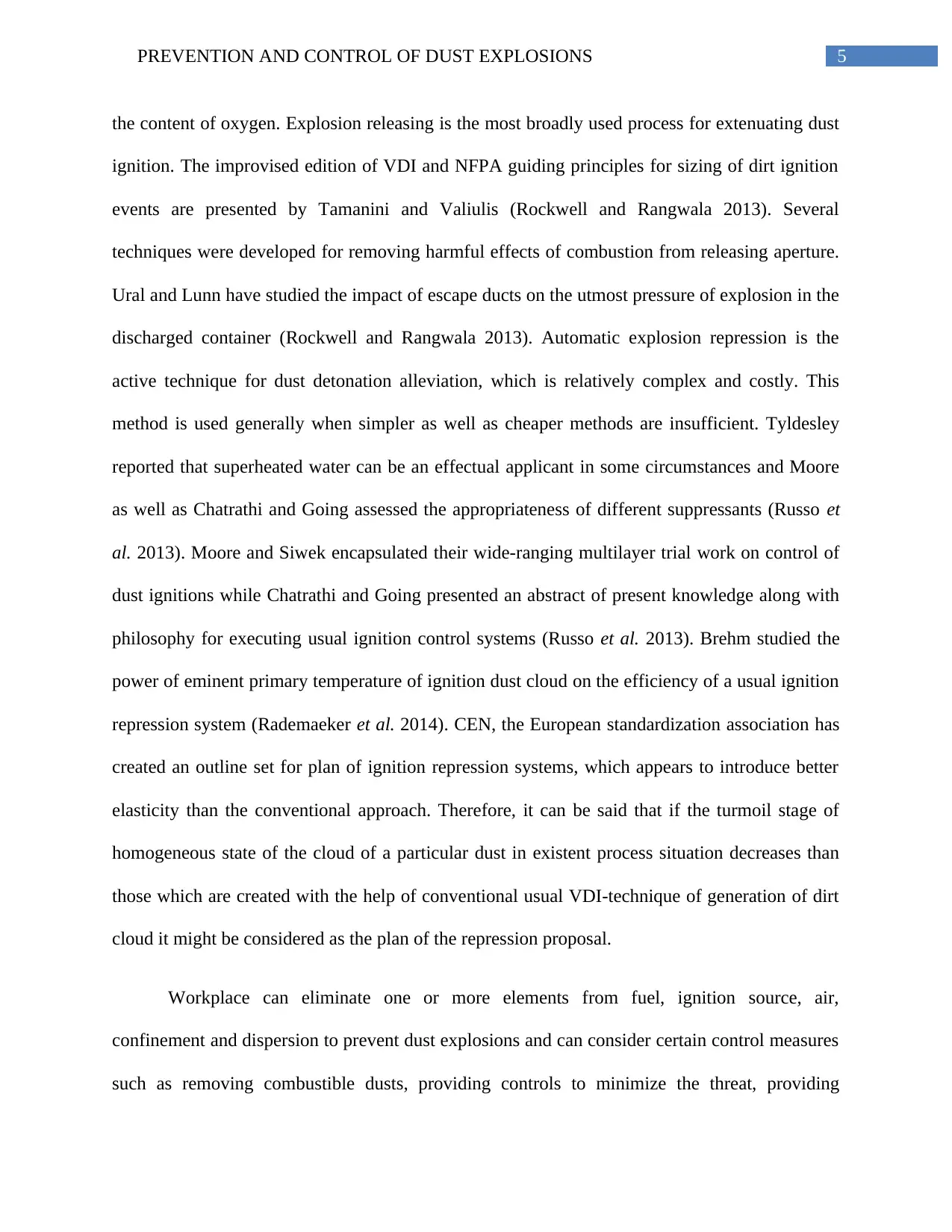
5PREVENTION AND CONTROL OF DUST EXPLOSIONS
the content of oxygen. Explosion releasing is the most broadly used process for extenuating dust
ignition. The improvised edition of VDI and NFPA guiding principles for sizing of dirt ignition
events are presented by Tamanini and Valiulis (Rockwell and Rangwala 2013). Several
techniques were developed for removing harmful effects of combustion from releasing aperture.
Ural and Lunn have studied the impact of escape ducts on the utmost pressure of explosion in the
discharged container (Rockwell and Rangwala 2013). Automatic explosion repression is the
active technique for dust detonation alleviation, which is relatively complex and costly. This
method is used generally when simpler as well as cheaper methods are insufficient. Tyldesley
reported that superheated water can be an effectual applicant in some circumstances and Moore
as well as Chatrathi and Going assessed the appropriateness of different suppressants (Russo et
al. 2013). Moore and Siwek encapsulated their wide-ranging multilayer trial work on control of
dust ignitions while Chatrathi and Going presented an abstract of present knowledge along with
philosophy for executing usual ignition control systems (Russo et al. 2013). Brehm studied the
power of eminent primary temperature of ignition dust cloud on the efficiency of a usual ignition
repression system (Rademaeker et al. 2014). CEN, the European standardization association has
created an outline set for plan of ignition repression systems, which appears to introduce better
elasticity than the conventional approach. Therefore, it can be said that if the turmoil stage of
homogeneous state of the cloud of a particular dust in existent process situation decreases than
those which are created with the help of conventional usual VDI-technique of generation of dirt
cloud it might be considered as the plan of the repression proposal.
Workplace can eliminate one or more elements from fuel, ignition source, air,
confinement and dispersion to prevent dust explosions and can consider certain control measures
such as removing combustible dusts, providing controls to minimize the threat, providing
the content of oxygen. Explosion releasing is the most broadly used process for extenuating dust
ignition. The improvised edition of VDI and NFPA guiding principles for sizing of dirt ignition
events are presented by Tamanini and Valiulis (Rockwell and Rangwala 2013). Several
techniques were developed for removing harmful effects of combustion from releasing aperture.
Ural and Lunn have studied the impact of escape ducts on the utmost pressure of explosion in the
discharged container (Rockwell and Rangwala 2013). Automatic explosion repression is the
active technique for dust detonation alleviation, which is relatively complex and costly. This
method is used generally when simpler as well as cheaper methods are insufficient. Tyldesley
reported that superheated water can be an effectual applicant in some circumstances and Moore
as well as Chatrathi and Going assessed the appropriateness of different suppressants (Russo et
al. 2013). Moore and Siwek encapsulated their wide-ranging multilayer trial work on control of
dust ignitions while Chatrathi and Going presented an abstract of present knowledge along with
philosophy for executing usual ignition control systems (Russo et al. 2013). Brehm studied the
power of eminent primary temperature of ignition dust cloud on the efficiency of a usual ignition
repression system (Rademaeker et al. 2014). CEN, the European standardization association has
created an outline set for plan of ignition repression systems, which appears to introduce better
elasticity than the conventional approach. Therefore, it can be said that if the turmoil stage of
homogeneous state of the cloud of a particular dust in existent process situation decreases than
those which are created with the help of conventional usual VDI-technique of generation of dirt
cloud it might be considered as the plan of the repression proposal.
Workplace can eliminate one or more elements from fuel, ignition source, air,
confinement and dispersion to prevent dust explosions and can consider certain control measures
such as removing combustible dusts, providing controls to minimize the threat, providing
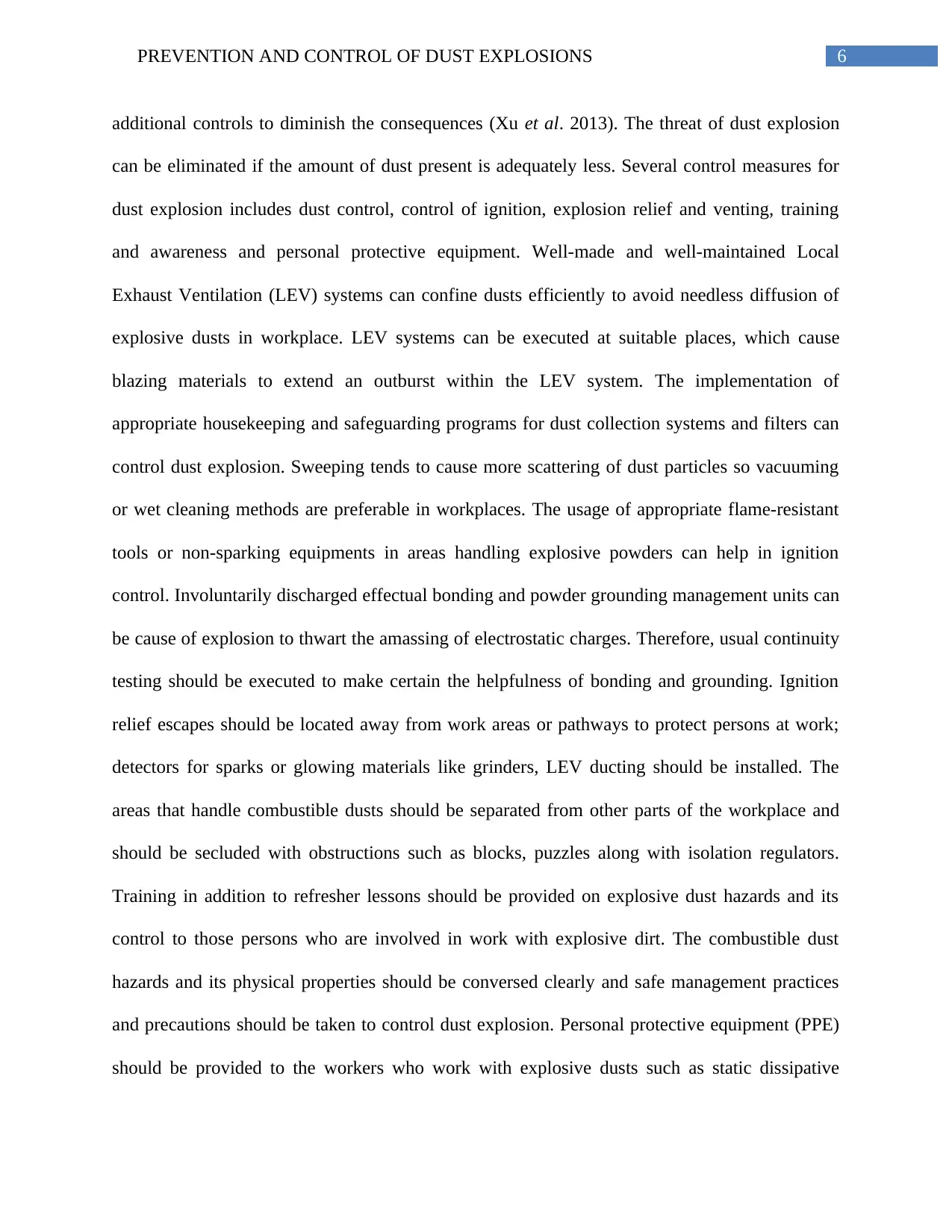
6PREVENTION AND CONTROL OF DUST EXPLOSIONS
additional controls to diminish the consequences (Xu et al. 2013). The threat of dust explosion
can be eliminated if the amount of dust present is adequately less. Several control measures for
dust explosion includes dust control, control of ignition, explosion relief and venting, training
and awareness and personal protective equipment. Well-made and well-maintained Local
Exhaust Ventilation (LEV) systems can confine dusts efficiently to avoid needless diffusion of
explosive dusts in workplace. LEV systems can be executed at suitable places, which cause
blazing materials to extend an outburst within the LEV system. The implementation of
appropriate housekeeping and safeguarding programs for dust collection systems and filters can
control dust explosion. Sweeping tends to cause more scattering of dust particles so vacuuming
or wet cleaning methods are preferable in workplaces. The usage of appropriate flame-resistant
tools or non-sparking equipments in areas handling explosive powders can help in ignition
control. Involuntarily discharged effectual bonding and powder grounding management units can
be cause of explosion to thwart the amassing of electrostatic charges. Therefore, usual continuity
testing should be executed to make certain the helpfulness of bonding and grounding. Ignition
relief escapes should be located away from work areas or pathways to protect persons at work;
detectors for sparks or glowing materials like grinders, LEV ducting should be installed. The
areas that handle combustible dusts should be separated from other parts of the workplace and
should be secluded with obstructions such as blocks, puzzles along with isolation regulators.
Training in addition to refresher lessons should be provided on explosive dust hazards and its
control to those persons who are involved in work with explosive dirt. The combustible dust
hazards and its physical properties should be conversed clearly and safe management practices
and precautions should be taken to control dust explosion. Personal protective equipment (PPE)
should be provided to the workers who work with explosive dusts such as static dissipative
additional controls to diminish the consequences (Xu et al. 2013). The threat of dust explosion
can be eliminated if the amount of dust present is adequately less. Several control measures for
dust explosion includes dust control, control of ignition, explosion relief and venting, training
and awareness and personal protective equipment. Well-made and well-maintained Local
Exhaust Ventilation (LEV) systems can confine dusts efficiently to avoid needless diffusion of
explosive dusts in workplace. LEV systems can be executed at suitable places, which cause
blazing materials to extend an outburst within the LEV system. The implementation of
appropriate housekeeping and safeguarding programs for dust collection systems and filters can
control dust explosion. Sweeping tends to cause more scattering of dust particles so vacuuming
or wet cleaning methods are preferable in workplaces. The usage of appropriate flame-resistant
tools or non-sparking equipments in areas handling explosive powders can help in ignition
control. Involuntarily discharged effectual bonding and powder grounding management units can
be cause of explosion to thwart the amassing of electrostatic charges. Therefore, usual continuity
testing should be executed to make certain the helpfulness of bonding and grounding. Ignition
relief escapes should be located away from work areas or pathways to protect persons at work;
detectors for sparks or glowing materials like grinders, LEV ducting should be installed. The
areas that handle combustible dusts should be separated from other parts of the workplace and
should be secluded with obstructions such as blocks, puzzles along with isolation regulators.
Training in addition to refresher lessons should be provided on explosive dust hazards and its
control to those persons who are involved in work with explosive dirt. The combustible dust
hazards and its physical properties should be conversed clearly and safe management practices
and precautions should be taken to control dust explosion. Personal protective equipment (PPE)
should be provided to the workers who work with explosive dusts such as static dissipative
Paraphrase This Document
Need a fresh take? Get an instant paraphrase of this document with our AI Paraphraser
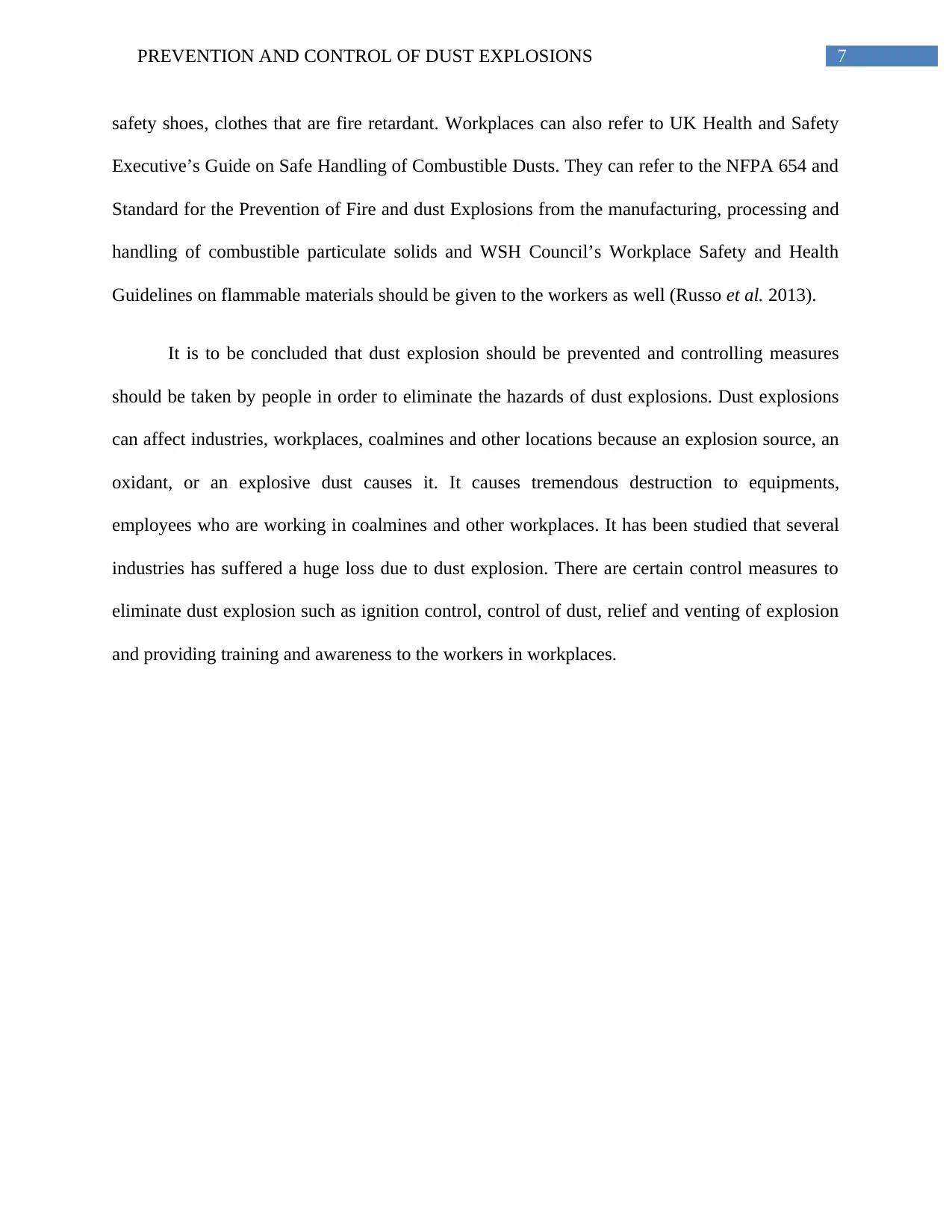
7PREVENTION AND CONTROL OF DUST EXPLOSIONS
safety shoes, clothes that are fire retardant. Workplaces can also refer to UK Health and Safety
Executive’s Guide on Safe Handling of Combustible Dusts. They can refer to the NFPA 654 and
Standard for the Prevention of Fire and dust Explosions from the manufacturing, processing and
handling of combustible particulate solids and WSH Council’s Workplace Safety and Health
Guidelines on flammable materials should be given to the workers as well (Russo et al. 2013).
It is to be concluded that dust explosion should be prevented and controlling measures
should be taken by people in order to eliminate the hazards of dust explosions. Dust explosions
can affect industries, workplaces, coalmines and other locations because an explosion source, an
oxidant, or an explosive dust causes it. It causes tremendous destruction to equipments,
employees who are working in coalmines and other workplaces. It has been studied that several
industries has suffered a huge loss due to dust explosion. There are certain control measures to
eliminate dust explosion such as ignition control, control of dust, relief and venting of explosion
and providing training and awareness to the workers in workplaces.
safety shoes, clothes that are fire retardant. Workplaces can also refer to UK Health and Safety
Executive’s Guide on Safe Handling of Combustible Dusts. They can refer to the NFPA 654 and
Standard for the Prevention of Fire and dust Explosions from the manufacturing, processing and
handling of combustible particulate solids and WSH Council’s Workplace Safety and Health
Guidelines on flammable materials should be given to the workers as well (Russo et al. 2013).
It is to be concluded that dust explosion should be prevented and controlling measures
should be taken by people in order to eliminate the hazards of dust explosions. Dust explosions
can affect industries, workplaces, coalmines and other locations because an explosion source, an
oxidant, or an explosive dust causes it. It causes tremendous destruction to equipments,
employees who are working in coalmines and other workplaces. It has been studied that several
industries has suffered a huge loss due to dust explosion. There are certain control measures to
eliminate dust explosion such as ignition control, control of dust, relief and venting of explosion
and providing training and awareness to the workers in workplaces.
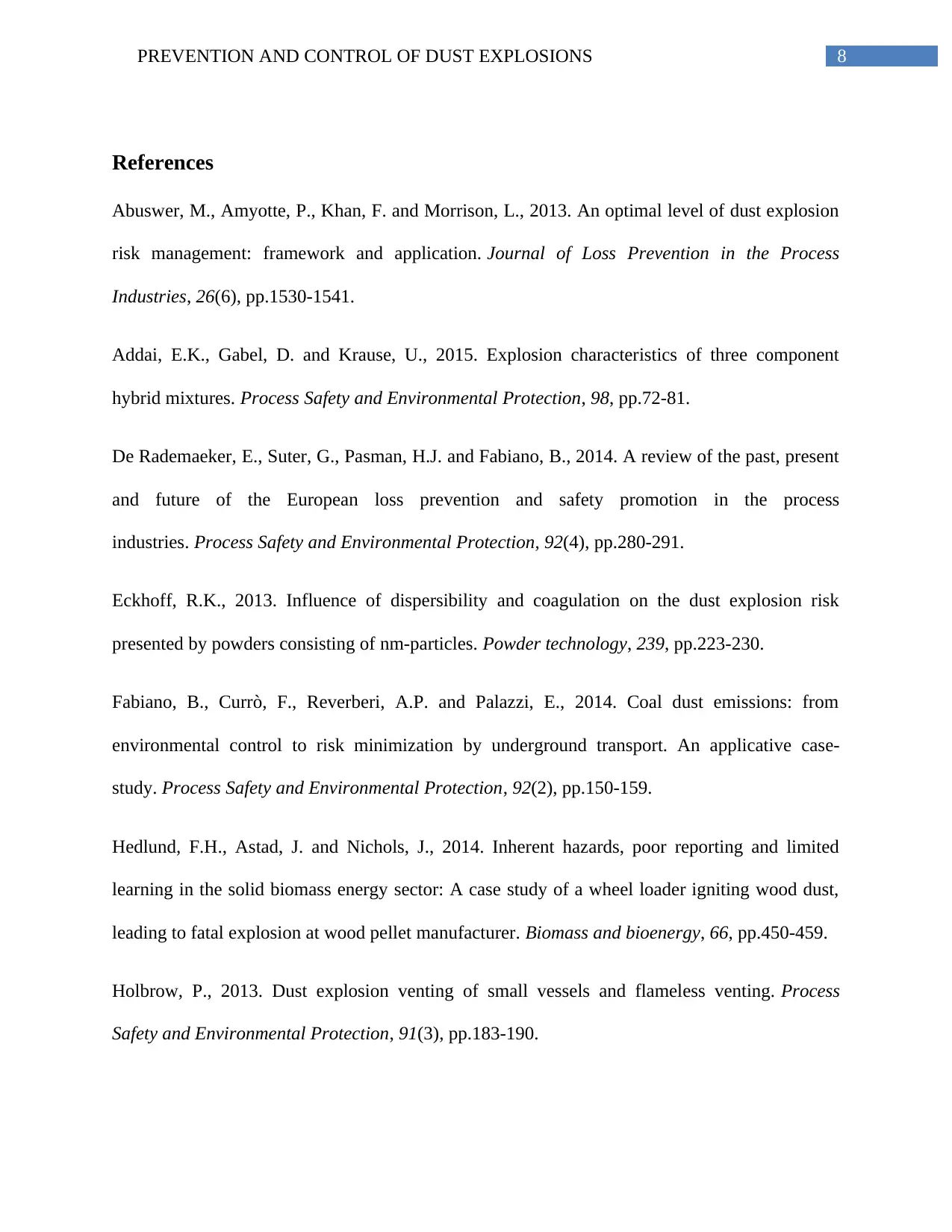
8PREVENTION AND CONTROL OF DUST EXPLOSIONS
References
Abuswer, M., Amyotte, P., Khan, F. and Morrison, L., 2013. An optimal level of dust explosion
risk management: framework and application. Journal of Loss Prevention in the Process
Industries, 26(6), pp.1530-1541.
Addai, E.K., Gabel, D. and Krause, U., 2015. Explosion characteristics of three component
hybrid mixtures. Process Safety and Environmental Protection, 98, pp.72-81.
De Rademaeker, E., Suter, G., Pasman, H.J. and Fabiano, B., 2014. A review of the past, present
and future of the European loss prevention and safety promotion in the process
industries. Process Safety and Environmental Protection, 92(4), pp.280-291.
Eckhoff, R.K., 2013. Influence of dispersibility and coagulation on the dust explosion risk
presented by powders consisting of nm-particles. Powder technology, 239, pp.223-230.
Fabiano, B., Currò, F., Reverberi, A.P. and Palazzi, E., 2014. Coal dust emissions: from
environmental control to risk minimization by underground transport. An applicative case-
study. Process Safety and Environmental Protection, 92(2), pp.150-159.
Hedlund, F.H., Astad, J. and Nichols, J., 2014. Inherent hazards, poor reporting and limited
learning in the solid biomass energy sector: A case study of a wheel loader igniting wood dust,
leading to fatal explosion at wood pellet manufacturer. Biomass and bioenergy, 66, pp.450-459.
Holbrow, P., 2013. Dust explosion venting of small vessels and flameless venting. Process
Safety and Environmental Protection, 91(3), pp.183-190.
References
Abuswer, M., Amyotte, P., Khan, F. and Morrison, L., 2013. An optimal level of dust explosion
risk management: framework and application. Journal of Loss Prevention in the Process
Industries, 26(6), pp.1530-1541.
Addai, E.K., Gabel, D. and Krause, U., 2015. Explosion characteristics of three component
hybrid mixtures. Process Safety and Environmental Protection, 98, pp.72-81.
De Rademaeker, E., Suter, G., Pasman, H.J. and Fabiano, B., 2014. A review of the past, present
and future of the European loss prevention and safety promotion in the process
industries. Process Safety and Environmental Protection, 92(4), pp.280-291.
Eckhoff, R.K., 2013. Influence of dispersibility and coagulation on the dust explosion risk
presented by powders consisting of nm-particles. Powder technology, 239, pp.223-230.
Fabiano, B., Currò, F., Reverberi, A.P. and Palazzi, E., 2014. Coal dust emissions: from
environmental control to risk minimization by underground transport. An applicative case-
study. Process Safety and Environmental Protection, 92(2), pp.150-159.
Hedlund, F.H., Astad, J. and Nichols, J., 2014. Inherent hazards, poor reporting and limited
learning in the solid biomass energy sector: A case study of a wheel loader igniting wood dust,
leading to fatal explosion at wood pellet manufacturer. Biomass and bioenergy, 66, pp.450-459.
Holbrow, P., 2013. Dust explosion venting of small vessels and flameless venting. Process
Safety and Environmental Protection, 91(3), pp.183-190.
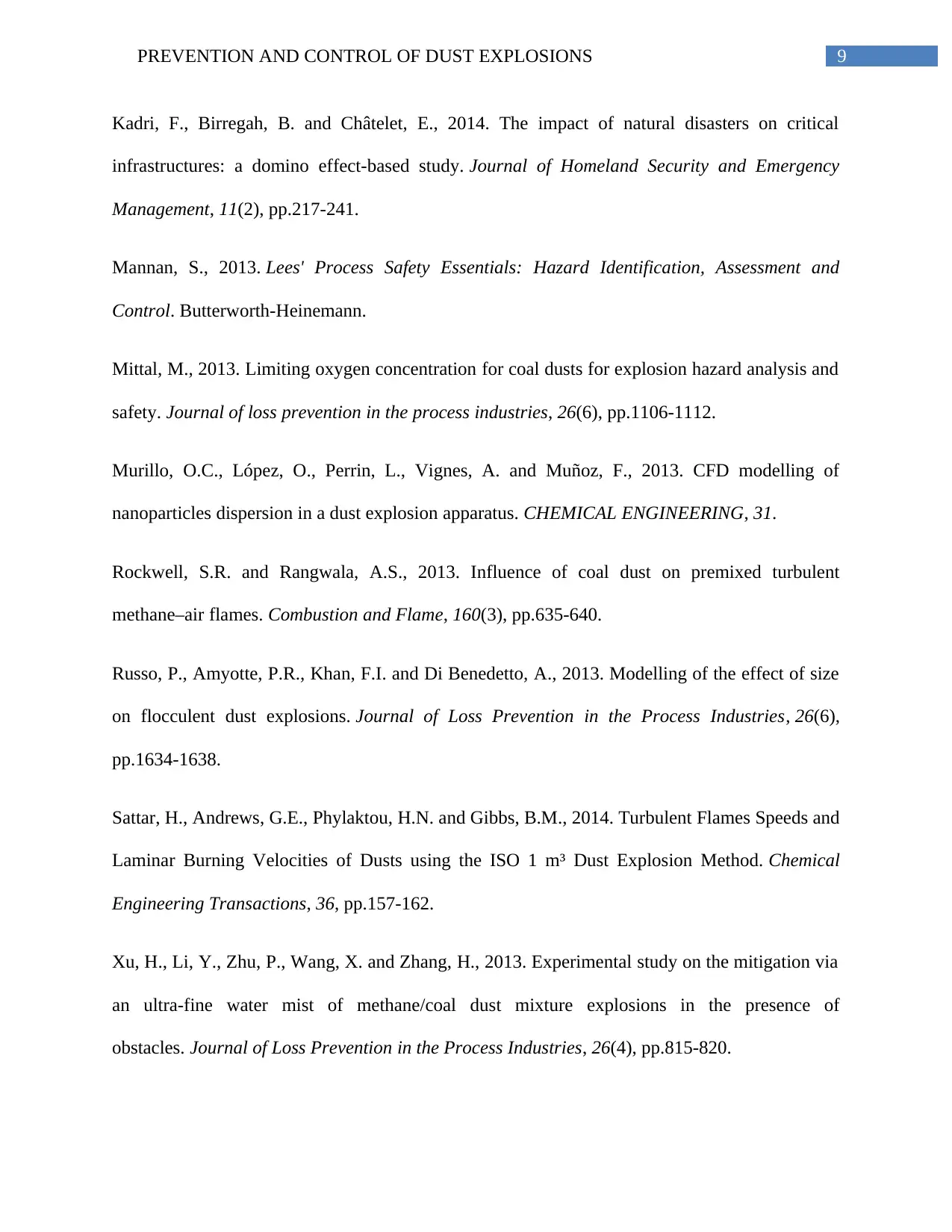
9PREVENTION AND CONTROL OF DUST EXPLOSIONS
Kadri, F., Birregah, B. and Châtelet, E., 2014. The impact of natural disasters on critical
infrastructures: a domino effect-based study. Journal of Homeland Security and Emergency
Management, 11(2), pp.217-241.
Mannan, S., 2013. Lees' Process Safety Essentials: Hazard Identification, Assessment and
Control. Butterworth-Heinemann.
Mittal, M., 2013. Limiting oxygen concentration for coal dusts for explosion hazard analysis and
safety. Journal of loss prevention in the process industries, 26(6), pp.1106-1112.
Murillo, O.C., López, O., Perrin, L., Vignes, A. and Muñoz, F., 2013. CFD modelling of
nanoparticles dispersion in a dust explosion apparatus. CHEMICAL ENGINEERING, 31.
Rockwell, S.R. and Rangwala, A.S., 2013. Influence of coal dust on premixed turbulent
methane–air flames. Combustion and Flame, 160(3), pp.635-640.
Russo, P., Amyotte, P.R., Khan, F.I. and Di Benedetto, A., 2013. Modelling of the effect of size
on flocculent dust explosions. Journal of Loss Prevention in the Process Industries, 26(6),
pp.1634-1638.
Sattar, H., Andrews, G.E., Phylaktou, H.N. and Gibbs, B.M., 2014. Turbulent Flames Speeds and
Laminar Burning Velocities of Dusts using the ISO 1 m³ Dust Explosion Method. Chemical
Engineering Transactions, 36, pp.157-162.
Xu, H., Li, Y., Zhu, P., Wang, X. and Zhang, H., 2013. Experimental study on the mitigation via
an ultra-fine water mist of methane/coal dust mixture explosions in the presence of
obstacles. Journal of Loss Prevention in the Process Industries, 26(4), pp.815-820.
Kadri, F., Birregah, B. and Châtelet, E., 2014. The impact of natural disasters on critical
infrastructures: a domino effect-based study. Journal of Homeland Security and Emergency
Management, 11(2), pp.217-241.
Mannan, S., 2013. Lees' Process Safety Essentials: Hazard Identification, Assessment and
Control. Butterworth-Heinemann.
Mittal, M., 2013. Limiting oxygen concentration for coal dusts for explosion hazard analysis and
safety. Journal of loss prevention in the process industries, 26(6), pp.1106-1112.
Murillo, O.C., López, O., Perrin, L., Vignes, A. and Muñoz, F., 2013. CFD modelling of
nanoparticles dispersion in a dust explosion apparatus. CHEMICAL ENGINEERING, 31.
Rockwell, S.R. and Rangwala, A.S., 2013. Influence of coal dust on premixed turbulent
methane–air flames. Combustion and Flame, 160(3), pp.635-640.
Russo, P., Amyotte, P.R., Khan, F.I. and Di Benedetto, A., 2013. Modelling of the effect of size
on flocculent dust explosions. Journal of Loss Prevention in the Process Industries, 26(6),
pp.1634-1638.
Sattar, H., Andrews, G.E., Phylaktou, H.N. and Gibbs, B.M., 2014. Turbulent Flames Speeds and
Laminar Burning Velocities of Dusts using the ISO 1 m³ Dust Explosion Method. Chemical
Engineering Transactions, 36, pp.157-162.
Xu, H., Li, Y., Zhu, P., Wang, X. and Zhang, H., 2013. Experimental study on the mitigation via
an ultra-fine water mist of methane/coal dust mixture explosions in the presence of
obstacles. Journal of Loss Prevention in the Process Industries, 26(4), pp.815-820.
Secure Best Marks with AI Grader
Need help grading? Try our AI Grader for instant feedback on your assignments.
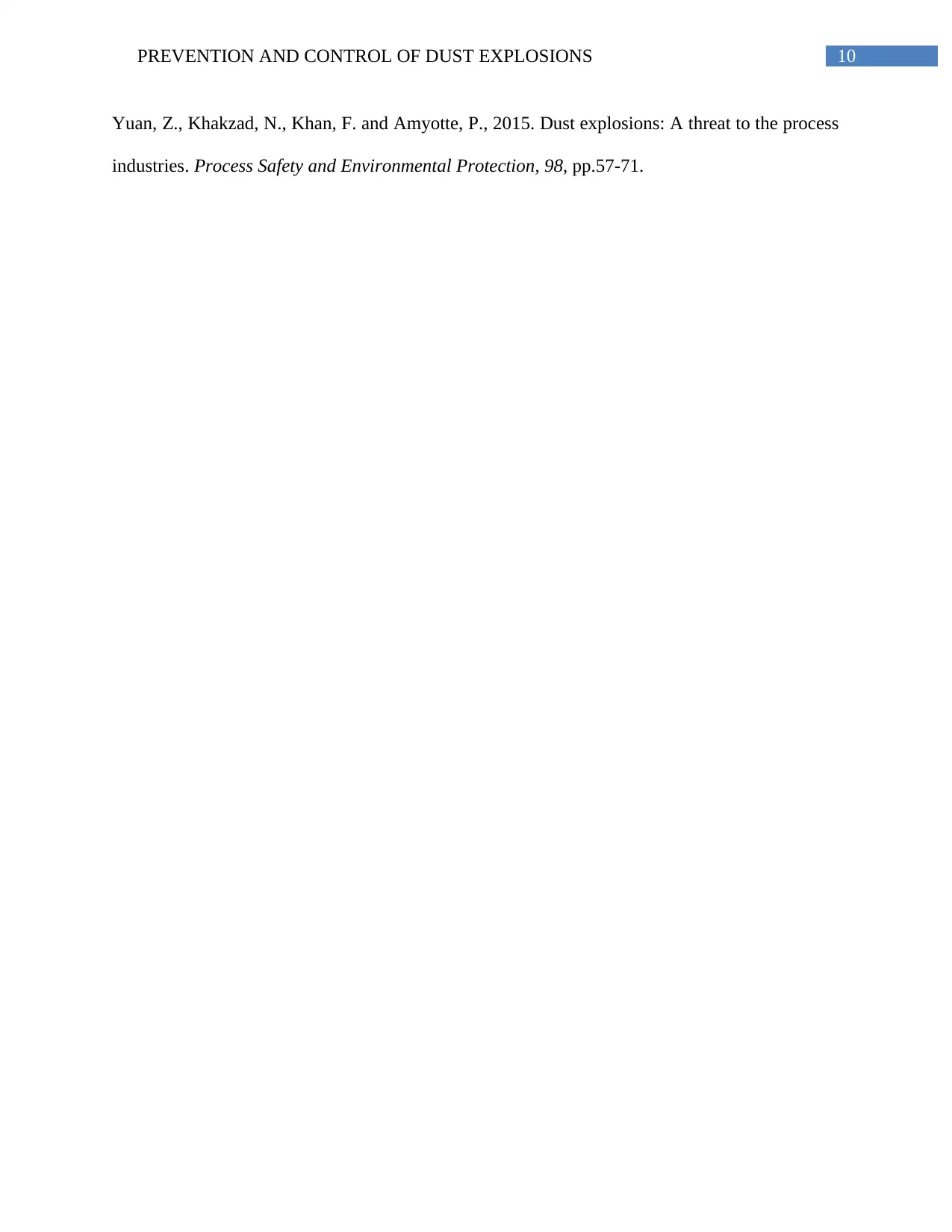
10PREVENTION AND CONTROL OF DUST EXPLOSIONS
Yuan, Z., Khakzad, N., Khan, F. and Amyotte, P., 2015. Dust explosions: A threat to the process
industries. Process Safety and Environmental Protection, 98, pp.57-71.
Yuan, Z., Khakzad, N., Khan, F. and Amyotte, P., 2015. Dust explosions: A threat to the process
industries. Process Safety and Environmental Protection, 98, pp.57-71.
1 out of 11
Your All-in-One AI-Powered Toolkit for Academic Success.
+13062052269
info@desklib.com
Available 24*7 on WhatsApp / Email
![[object Object]](/_next/static/media/star-bottom.7253800d.svg)
Unlock your academic potential
© 2024 | Zucol Services PVT LTD | All rights reserved.
